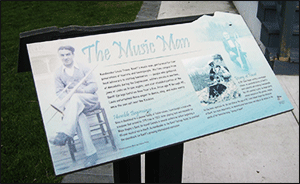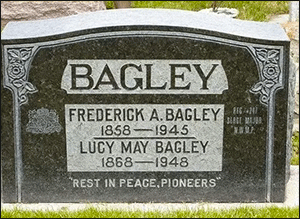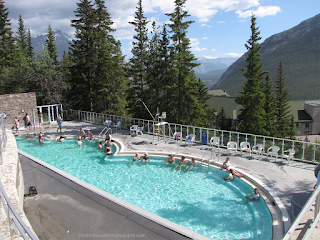 |
| Fred Bagley |
I arrived about 5:00 to a town undergoing what looked like open heart surgery. Banff's Avenue had been fenced off. Huge diggy machines and bulldozers were hard at work along the center. I made a U-turn and headed for Bankhead, the old CPR ghost town Louis had made come alive in my mind and heart. Once a thriving community of immigrants brought in from all over Europe to mine the coal, this once-upon-a-time pristine town was home to about one hundred Germans, Ukranians, Italians, and others...and Chinese. A town of Once Upon A Time.
 |
| Main Street, Bankhead AB, circa 1910 |
 |
| Holy Trinity Church, Bankhead AB |
 |
| All that's left today Photo by Trip Advisor |
 |
| Two Jack Lake |
Your granddad came out from Banff to start a band. I wanted to play trumpet, but no matter how many times I asked he kept saying I was just a kid. Finally, to shut me up, I think, he gave me his own trumpet and told me to take it home for a week, see what I could do. When I finished playing for him the following week, he said to the band members, :Now here is how you play music." But he had enough trumpet players. He gave me a trombone. I've been playing trombone ever since, all over the world.I settled down with a crackling fire under the black pine, content to be “home,” listening to the music of my great-grandfather reaching through time and playing in the trees--and looking forward to knocking on Louis' door the next day to say hi. Perhaps a dinner at Banff Springs Hotel would be fun, where Louis still played his trombone in what was left of my great-grandfather's "Banff Hot Spring Hotel Band."
 I was saddened to learn the next day from the curators at the Whyte Rocky Mountain Museum that Louis had died three years before, his wife just three weeks ago. Had it been that long since I'd been to Banff? I had to blink a few times.
I was saddened to learn the next day from the curators at the Whyte Rocky Mountain Museum that Louis had died three years before, his wife just three weeks ago. Had it been that long since I'd been to Banff? I had to blink a few times.The good news, the curators were quick to share, was that Banff had renamed the bandstand for Louis and installed a lovely plaque with a bit of Louis’ fascinating musical history. I was not surprised to find Fred mentioned as his mentor and teacher. How rich my life has been by looking for my missing grandmother. First Fred, then Uncle Dale. Louis. Banff feels a little lonely for me now, without my friend.

Getting any information on where Fred and Lucy May might have lived, though, was a bit elusive. In the public library, I found a huge book called I Live In A Postcard, a collection of histories on Banff's families. Fred and Lucy May weren't listed. Next door at the museum archives they were equally surprised, but pictures of his funeral show a long line of friends stretching all down Banff Avenue, many of them stepping into the cortege as the hearse rounded the corner onto Buffalo and out to the cemetery. His hearse was accompanied by six Mountie, three to the left, three to the right, Mounties stationed all along the way, each raising an arm in salute as my grandfather passed for the last time.
A curator found some color slides. Goodness. The day was ablaze with autumn orange leaves and riotous red tunics! I hadn't yet been born but I could smell the day deep inside.
 I went straight to the cemetery and had a picnic supper at his grave, where he’d been interned with a Union Jack draped over his coffin. I’d stopped on the way up to see one of Mum's many Goodfellow cousins in Salmon Arm, BC. Sylvia was exactly half way between home and Banff, a convenient stopover. After some lunch she'd sent me on my way with an egg salad sandwich and other hand baked goodies. Now, perched on the Bagley plot's concrete edging, with the chilly granite of the tombstone at my back, I munched it all down, looking up at Sulphur Mt. as it plunged skyward in a blanket of trees. I got to thinking about the entrapment of time—a terrible inconvenience for writers and historians. How is that I was sitting here, alive, with Fred dead and my grandchildren having their whole lives ahead of them? Weird.
I went straight to the cemetery and had a picnic supper at his grave, where he’d been interned with a Union Jack draped over his coffin. I’d stopped on the way up to see one of Mum's many Goodfellow cousins in Salmon Arm, BC. Sylvia was exactly half way between home and Banff, a convenient stopover. After some lunch she'd sent me on my way with an egg salad sandwich and other hand baked goodies. Now, perched on the Bagley plot's concrete edging, with the chilly granite of the tombstone at my back, I munched it all down, looking up at Sulphur Mt. as it plunged skyward in a blanket of trees. I got to thinking about the entrapment of time—a terrible inconvenience for writers and historians. How is that I was sitting here, alive, with Fred dead and my grandchildren having their whole lives ahead of them? Weird.My second day it was back in the archives, where Lena, one of the curators, pulled out the old tax records, heavy tombs of boring information like lot and block and assessed value. I learned that Fred never owned his house—there are no records of him ever paying taxes. The Goodfellows, however, had a cabin and property worth $650. Taxes ran from $6 to about $11 or $12.
 |
| Craig Cabin perhaps similar to the Goodfellows |
Rats, rats, and more rats. I had my heart set on being snoopy. I did find the answer, though, as to how awkward it might have been for the families--one trying to see their granddaughter, the other determined they not. Answer: Very awkward.
 |
| Banff Hot Springs |
A friend and I used tell each other stories of complete strangers we’d see. So there I was the night before, reveling in the hot springs that's made Banff so famous, making up stories about the various people I saw. I had this guy pegged for a banker, widower, living in his head and trying to pull himself out of it. At the library we started to chat. Turns out he's researching residential schools in Canada for an online class he was taking. Shows how remarkably creative I can be.
In the morning I was to head down to Pincher Creek to meet my mother’s “missing” cousin, Doug Connelly. By the way, Pincher Creek is where the Mounties raised their horses and where Old Buck, Grandfather's horse, was put to pasture after many years of service. The town that grew up around the Mountie horse ranch is nestled in the Rocky Mountain foothills, and I am quite fond of the rolling, dry countryside, caught as it is between the mountains and plains. I look forward to meeting more Bagley kin, and to learn what memories Doug may have of his grandfather.
For a treat, I stayed my last night at the Banff Hostel, a grand place for little money and all the amenities. Best yet, the old Train Depot hauled out of Bankhead in 1922 sits right next door.
I can't believe it. I'm right back to Once Upon A Time!
 |
| Yup, that's me! |

No comments:
Post a Comment
If you'd like to comment, I'd love to hear from you.